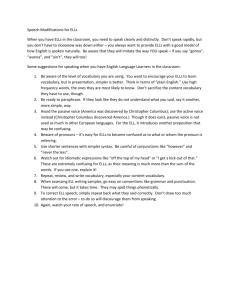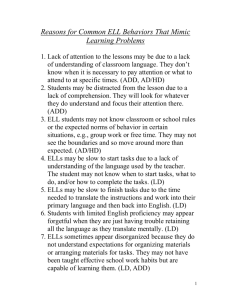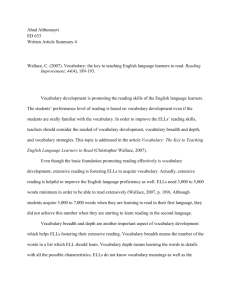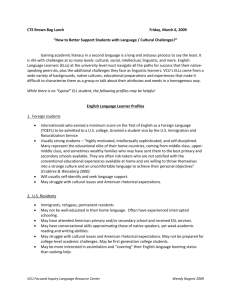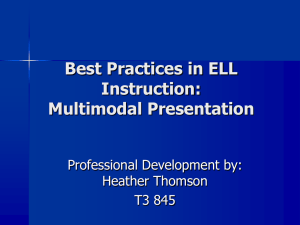ACCOMMODATIONS IN THE CLASSROOM Teachers
advertisement
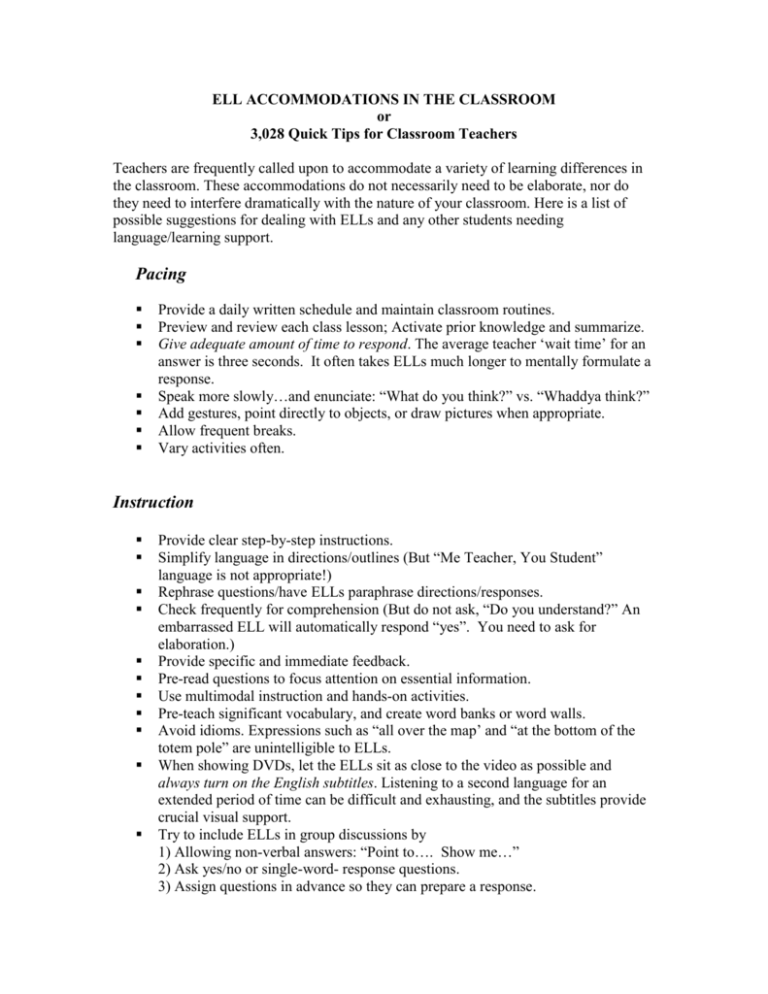
ELL ACCOMMODATIONS IN THE CLASSROOM or 3,028 Quick Tips for Classroom Teachers Teachers are frequently called upon to accommodate a variety of learning differences in the classroom. These accommodations do not necessarily need to be elaborate, nor do they need to interfere dramatically with the nature of your classroom. Here is a list of possible suggestions for dealing with ELLs and any other students needing language/learning support. Pacing Provide a daily written schedule and maintain classroom routines. Preview and review each class lesson; Activate prior knowledge and summarize. Give adequate amount of time to respond. The average teacher ‘wait time’ for an answer is three seconds. It often takes ELLs much longer to mentally formulate a response. Speak more slowly…and enunciate: “What do you think?” vs. “Whaddya think?” Add gestures, point directly to objects, or draw pictures when appropriate. Allow frequent breaks. Vary activities often. Instruction Provide clear step-by-step instructions. Simplify language in directions/outlines (But “Me Teacher, You Student” language is not appropriate!) Rephrase questions/have ELLs paraphrase directions/responses. Check frequently for comprehension (But do not ask, “Do you understand?” An embarrassed ELL will automatically respond “yes”. You need to ask for elaboration.) Provide specific and immediate feedback. Pre-read questions to focus attention on essential information. Use multimodal instruction and hands-on activities. Pre-teach significant vocabulary, and create word banks or word walls. Avoid idioms. Expressions such as “all over the map’ and “at the bottom of the totem pole” are unintelligible to ELLs. When showing DVDs, let the ELLs sit as close to the video as possible and always turn on the English subtitles. Listening to a second language for an extended period of time can be difficult and exhausting, and the subtitles provide crucial visual support. Try to include ELLs in group discussions by 1) Allowing non-verbal answers: “Point to…. Show me…” 2) Ask yes/no or single-word- response questions. 3) Assign questions in advance so they can prepare a response. Provide study guides and review time. Give concrete examples. Use graphic organizers to assure that your student comprehends complex material in a less text-dense way. Environment Seat ELLs near the teacher, and away from distracting influences. Keep daily assignments posted. Display monthly calendar with due dates. Assign a "buddy" to sit next to ELLs. They don’t have to explain everything— they just need to make sure the ELL is on the right page, answering the right question, using the correct lab equipment, etc. Assign tutors if possible for additional one-on-one help. For pair or co-operative group work, assign ELLs to a native-speaking partner, or to group of native speakers, not other ELLs. Homework Assignments Give directions orally and in writing. Create timelines for lengthy assignments. Decrease amount (not content) of homework. Modify the number of required problems. Offer students models of major assignments, and check work at each step. Maintain assignment binder for classroom or post assignments on-line. If possible, highlight the most important information in the text. Provide books on tape. The student can work on aural/oral skills and pronunciation. Allow for extended time if appropriate—but be reasonable. A conscientious ELL may spend as much time on an assignment as necessary to complete it. But do you want an ELL to spend three hours on homework that the average native speaker would take twenty minutes to complete? Much better to reduce the amount of homework, or give them a time limit. Use simplified or leveled texts if available. (I have a fair number of simplified classic literary texts in my classroom.) Graphic editions of literature can also be helpful. Communication/Affective Needs Check-in regularly with student. Check in regularly with ELL teacher when you have questions or concerns. Focus on pride in individual progress rather than comparisons with others. Write "see me" on papers to allow for personal explanations of corrections. Recognize student success overtly and frequently, but be aware than in some (particularly Asian) cultures, individual praise is considered inappropriate and can be embarrassing to the student. Testing Allow extended time if needed. Instead of vocabulary-heavy multiple choice tests, give ELLs openended questions (“Tell me about the ancient Egyptians.”) This allows them to demonstrate knowledge of content rather than their ability to use English. Provide study guides and allow time for review. Provide a word bank. Reduce the number of choices on tests and quizzes, especially if they are language-heavy multiple choice. E.g., have ELLs answer only the even- or odd-numbered questions. For essay tests, reduce the amount of writing necessary. E.g., let them choose two out of the three questions, or let them write a threeparagraph instead of a five-paragraph essay.

